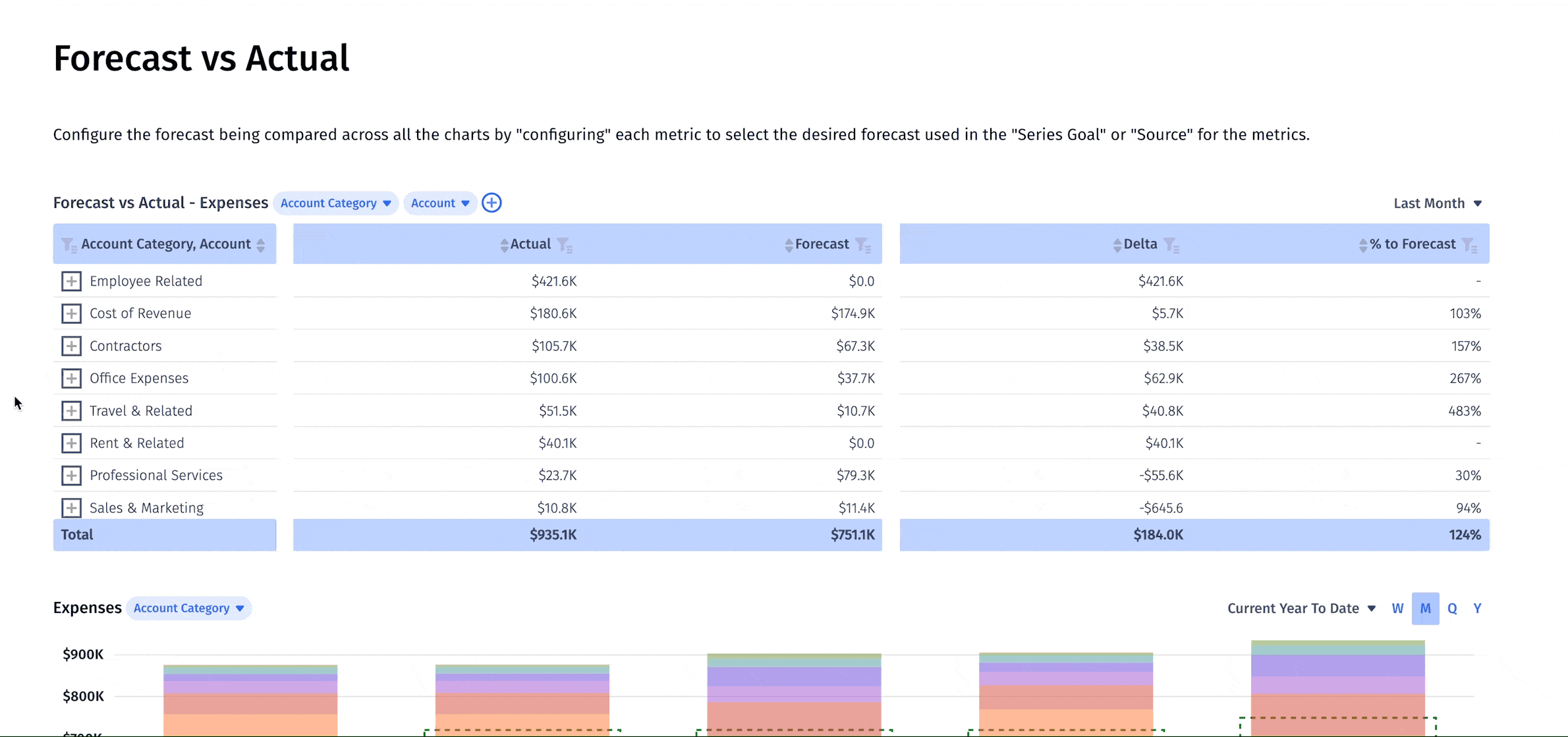When you see finance leaders like Paul Barnhurst, The FP&A Guy, say things like, “I personally have always felt the budgeting process was of limited value,” they’re talking about the most traditional, stereotypical workflow.
The one that every employee in and out of finance dreads. The one that’s filled with more office politicking than collaborative, strategic thinking. And the one that leaves you with a static budget.
There are plenty of problems with the traditional budgeting process. But there are just as many issues with that final static budget output. If you’re still going through the planning motions to come up with a static budget that doesn’t offer value to the company, it’s time to rethink your process and build more flexible plans.
Table of Contents
What Is a Static Budget?
A static budget is a type of budget that is fixed for a specific period (typically a fiscal year). A company operates according to that fixed budget for the given time period and only reallocates when the next budgeting period begins. A 1-year static budget is common, but in some cases, companies may opt for shorter static periods, such as six months, or choose to apply an incremental budgeting approach to adjust the existing budget by small amounts throughout the period.
Like any other type of budget, your static budget will cover the main expense/departmental categories:
- General and administrative
- Sales and marketing
- Research and development
- Cost of revenue
Static budgets act as a performance benchmark throughout the period. During this time, actual results are compared to the budget using variance reports, and finance teams can analyze differences between the two. While a static budget provides a strategic planning and decision-making baseline, it does not always allow for the most accurate or useful budgeting tool for SaaS companies.
Emphasis on “Fixed”
Static budgets are often called fixed budgets because they do not change during the specific period they’re in effect — no matter the fluctuation.
So, if the actual sales volume decreases unexpectedly, the budget doesn’t change. Teams are still holding their original budget allocation for the remainder of the period despite the fact that actual revenue is far lower than expected. Or, let’s get optimistic — what if sales sharply increase? So, too, does the cost of production (which includes engineer and customer support). And, so, too, does the static budget variance.
The static budget is not made to be responsive to favorable and unfavorable variances over the given period. And while you can mitigate this drawback by changing the budget’s time horizon, this is an important limitation regarding the functionality of a fixed budget.
Static Budget Example
Let’s look at a pared-down budgeting example to see how static budgets work. Let’s imagine a startup’s budgeted costs for fixed expenses for one month are as follows:
- Rent: $31,000
- Employee related (salaries and benefits): $238,000
- Office Expenses: $28,000
- Legal & Professional: $13,000
And the variable costs are
- Sales and marketing: $65,000
- Cost of revenue: $165,000
- Travel and related: $2,440
- Corporate expenses: $41,950
That brings the total monthly budget to $584,390.
During the budgeting period, let’s say cost of revenue increases unexpectedly by $2,700 due to unexpected price increases on software the engineering team uses, as well as hosting costs increasing due to increased website traffic. But the marketing department also decides not to push a campaign, which saves their team $2,500.
The actual cost doesn’t affect the static budget. Instead, finance teams review the difference between the budget and actual costs at the end of the budgeting period. These differences are known as budget variances.
What Is Static Budget Variance?
A static budget variance occurs when actual budgeted expenses are higher or lower than expected. The finance team will investigate that budget variance by conducting a budget variance analysis, where they review the entire budget to look for any variances, then go to department leaders to determine why something may be higher or lower than expected.
If you’re committed to keeping the budget fixed, these variances will help you tell the narrative of financial performance in the short term. But in the long term, they’ll help you evaluate budget changes when the next planning process starts. The goal is to identify new obstacles and opportunities with the company’s budget that not only affect the bottom line but make continuous impacts around revenue, runway, and overall efficiency.
Give Department Leaders Deep Financial Insights for Better Budgeting

The Benefits of Using Static Budgets
By definition, static budgets offer limited opportunities to adapt to new information about the business. While that may sound like a major disadvantage in any situation, there are still a few benefits to maintaining a fixed budget.
Predictability
Static budgets provide a predictable framework for financial planning and allow department leaders to set clear financial goals based on well-defined parameters, which allows them to track progress effectively.
Cost Management
With specific targets for variable expenses, static budgets help department heads control costs and avoid overspending. The budget remains exactly what it is, so departments determine exactly where they can optimize or cut spend.
Clear Performance Evaluation
Finance teams can easily identify strengths and weaknesses across the company by reviewing a static budget. The framework makes it easy to evaluate the performance of different business initiatives and departments. And once variances are identified, finance can go to department and executive leaders to flag any concerns or opportunities to make the budget work even better for the business.
When Should a SaaS Business Use a Static Budget?
Today’s marketplace requires flexibility and agility. To that end, static budgets lack the functionality required by a growing SaaS startup with the moon in its sights or a mid-growth stage company looking to expand. And as customers respond to rapidly changing market conditions, so must the company’s budget. While flexible budgeting and rolling forecasts enable teams to pivot on a dime, a rolling budget offers another dynamic approach to address changing conditions.
Static budgets offer some functionality, especially in the early seed stages. Does your team need to plan where resources from recent funding will go? A static budget may be in order — and may be used as a guideline for flexible budgeting. It’s also suitable in the early stages when you don’t have historical data to rely on for budget forecasting (or simply don’t have the team to support the task).
How to Create a Static Budget in 8 Steps
Your business budget, no matter what method you use, should be a key resources for your business to
- Maintain financial control and operational efficiency
- Support open communication between finance and department heads
- Make informed, strategic decisions about growth plans
Creating a static budget (or any kind of financial plan) requires a foundation of reliable historical data. So, if you haven’t established data hygiene best practices or a solid month-end close process, start there (or start using business budgeting software). “. But with that foundation in place, you can focus on smoothing out the budgeting process.
You’ll need access to financial statements for this project, including the income statement and master budget (if there is one) that holds any historical data (if available). From there, you can create your static budget and monitor it.
1. Define the Budget Period and Process
Your first step is to confirm what executive leadership decides will be the length of time the budget will be in effect. The traditional pace has been annual, but for companies that want to ensure they can make actionable decisions around budgets, one month or one quarter are common. If the budgeting period is too short, the process becomes more time-consuming. Too long, you amplify some of the disadvantages of working with a static budget.
The budgeting process itself also needs to be decided — as in, whether it will be a top-down vs. bottom-up budgeting approach. Top-down requires executive leaders to dictate how much each department receives, then let department leaders allocate the budget. Bottom-up is the opposite, where department leaders will specify how much they would like per line item, with executive leadership having final approval.
2. Identify Revenue Sources and Amounts
Begin by identifying your revenue sources — subscription fees, ad revenue, etc. — and estimate the revenue you expect to generate over the defined time period. This step may also benefit from creating a sales forecast, where you estimate the number of customers you expect to have over the period, the average revenue per customer, and your expected churn.
3. Estimate Cost of Revenue and Operating Expenses
Your cost of revenue represents your production costs (based on predictable sales). You’ll want to break down your cost of revenue estimates by revenue stream, and you’ll want to differentiate between variable and fixed costs for each.
The net operating costs are the other half of the cost puzzle. Here, you include overhead costs such as salaries, rent, ad spend, and other costs. Again you want to break these down into subcategories so that you have a full view of where money is going.
4. Estimate Net Income
Now that you have your estimated revenues and costs, you can calculate your net income based on those estimates. This is to help your team understand how much profit you expect — or how much of your cash reserves you expect to burn during the period.
5. Calculate the Budget
This is where you do your forecasting. Of course, you’ll be subtracting your costs from your expected revenue so that you can estimate future net income. That will help you estimate future cash reserves and effects on resiliency metrics, such as your cash runway.
6. Review and Adjust the Budget
During the review stage, the budget is shared with all important stakeholders so that they may comment on the budget. Getting executive leaders and department heads input ensures that everything is covered and up to date.
7. Monitor and Communicate Budget Performance
As you progress through the budgeting period, track how the business is performing in relation to projections. You’ll also want to give your stakeholders periodic performance updates, alongside ensuring you flag any immediate concerns or opportunities that may affect the next round of budget allocations.
8. Review Performance
Finally, at the end of the budget period, it’s time for review. This is when you can dig into budget analysis — especially by reviewing variances — and uncover opportunities for growth.
Mosaic Can Help With Any Budgeting Process
SaaS companies that are able to respond quickly to changes in customer behavior and market demand are companies that turn obstacles into immense opportunities. But to do so, finance teams need the proper tools.
Enter Mosaic, the first Strategic Finance Platform made by SaaS financial teams for SaaS finance teams. Mosaic offers 150+ out-of-the-box metrics alongside templates and dashboards that quickly pave the way for innovative thinking and strategic financial planning.
Gain More from Forecasting
Mosaic enables finance teams to create and analyze an array of budgeting scenarios based on different assumptions and variables. This can help finance teams identify potential risks and opportunities and make informed decisions about resource allocation and budgeting priorities.
Go Deeper with Financial Analysis
Mosaic’s robust analytic and reporting tools turn business performance data into actionable insights. With real-time data syncs, teams won’t miss an opportunity to identify changes in cash flow, revenue, or any other line item on the budget.
More importantly, teams can dive deeper into the data to uncover potential issues and resolve them quickly by utilizing Mosaic’s out-of-the-box, customizable financial dashboards, like the forecasts vs. actuals dashboard, that helps teams cut budget allocation down from a two-week process to two days.

Ready to push your budget from static to strategic? Request a personalized demo today.
Static Budget FAQs
What is the difference between a static and a flexible budget?
A static budget is a budget set for a certain period of time and stays the same over that period, regardless of business performance or activity levels. A flexible budget is one that changes based on customer activity, business performance, and other factors.
A flexible budget is meant to respond dynamically to the business environment. Because of its dynamic nature, a flexible budget is better suited to SaaS companies.
When should you use a static budget?
What are the drawbacks of using a static budget?
Own the of your business.

